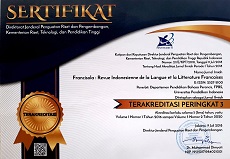TRANSLATION STRATEGIES IN EUROPEAN AND CANADIAN FRENCH VERSIONS OF AN ANIMATED MOVIE’S ORIGINAL SOUNDTRACK
Abstract
RÉSUMÉ. Comme un processus qui implique plusieurs langues, traduction peut être appliquée à diverses formes de médias, tels que des films, des livres et des chansons. Dans les traductions de film, ce processus parfois inclut non seulement les dialogues, mais aussi les chansons (bande originale). Cette étude vise à décrire l’application de stratégies de traduction dans deux versions françaises (européenne et canadienne) de bande-son de The Lion King II: Simba’s Pride. Les chercheurs utilisent deux théories de stratégies d’application : traduction de la poésie (Lefevere, 1975) et traduction sur le plan lexical (Baker, 1992). Après l’analyse, les auteurs prennent une conclusion que les résultats variés de la traduction sont fortement influencés par interprétation et aucun problème de non-équivalence ne se trouve.
Mots-clés : bande-son, dessins animés, paroles, stratégies de la traduction.
ABSTRACT. As a process that involves more than one language, translation can be applied in various forms of media, such as film, books and songs. In movie translations, this process sometimes includes not only the dialogues, but also the songs (original soundtrack). This study aims to describe the application of translation strategies in two French versions (European and Canadian) of The Lion King II: Simba’s Pride’s original soundtrack. The authors use two theories of translation strategies: Lefevere’s poetry translation (1975) and Baker’s word-level translation (1992). After the analysis was done, the author concluded that the various results of translation were heavily influenced by interpretation, but that no non-equivalence problem was found however.
Keywords: cartoon, lyrics, soundtrack, translation strategies.
Full Text:
PDFReferences
Aminoroaya, S and Amirian, Z. (2016). Investigating the Translation of Songs in Persian Dubbed Animated Movies. Journal of Translation and Interpretation, 10(2), 44-68.
Baker, M. (1992). In other words: A course book on translation. London: Routledge.
Bassnett, S. (2002). Translation studies (3rd ed.). London: Routledge.
Franzon, J. (2008). Choices in song translation: Singability in print, subtitles and sung performance. The Translator, 14(2), 373-399.
Lindsay, D. (2016). You might wrongly disagree but The Lion King 2 is better than the original and here’s why. Retrieved from http://metro.co.uk/2016/02/13/you-might-wrongly-disagree-but-the-lion-king-2-is-better-than-the-original-and-heres-why-5676939/
Low, P. (2005). The Pentathlon approach to translating songs. In Gorlée, D. L. (2005). Song and Significance: Virtues and Vices of Vocal Translation. Amsterdam and New York: Rodopi. 185-212.
Low, P. (2013). When songs cross language borders. The Translator, 19(2), 229-244.
Marc, I. (2015). Travelling songs: on popular music transfer and translation. Journal of the International Association for the Study of Popular Music, 3-21.
Nedd, A. (2014). An Authoritative Ranking of Disney Sequels. Retrieved from https://www.buzzfeed.com/alexisnedd/an-authoritative-ranking-of-disney-sequels?utm_term=.vvygxZAQR#.thXJp6j07
Nida, E. A. (1964). Toward a science of translating: with special reference to principles and procedures involved in Bible translating. Leiden: Brill.
Puigderajols, A. M. R. (2001). A linguistic study of the magic in Disney lyrics. Barcelona: Barcelona University.
Warachananan, P. & Roongrattanakool, D. (2015). A study of translation strategies in the translation of songs in Walt Disney’s animated feature films into Thai versions. Retrieved from http://gs.nsru.ac.th/files/5/7%20ปณณภา%20%20วรชนานันท์.pdf
DOI: https://doi.org/10.17509/francisola.v2i2.9410
Refbacks
- There are currently no refbacks.
Copyright (c) 2017 FRANCISOLA

This work is licensed under a Creative Commons Attribution-ShareAlike 4.0 International License.
View My Stats











